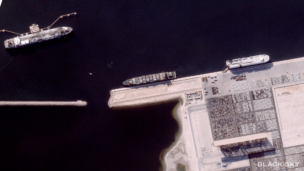Deutsche Bank has initiated coverage on Planet ($PL) with a $7 price target and BlackSky ($BKSY) with a $3 target, issuing buy ratings on both companies, according to a note seen by Payload.
Why EO? Space technology is a difficult and capital-intensive endeavor, which raises red flags for risk-averse investors (and especially when frothy markets are no more). But DB believes that Planet and BlackSky have a track record of generating revenue and avoiding pitfalls that have historically plagued the sector.
DB pulled numbers from Euroconsult and Allied Research to assess EO’s current TAM, or total addressable market, at ~$6B. The bank expects that to grow to $10B by 2025.
- Over the coming decades, DB expects the TAM to grow by up to 6x, topping out somewhere between $19B and $40B.
- This growth estimate is driven mainly by increased commercial adoption in the energy, agriculture, and defense sectors, as AI and analytics for EO data get more sophisticated.
THE platform: Planet’s global, daily coverage through its in-house constellation, its ability to cheaply and quickly iterate on its satellite design, and the depth of its offerings from raw data to packaged analytics caught DB analysts’ eyes.
“Planet in our view represents an EO platform with multiple solutions to cater to [the] widest range of customers especially on the commercial side, underpinned by [a] best-in-class management team,” the analysts wrote. “Its highly recurring revenue profile should eventually command a valuation premium in our view, similar to leading software companies.”
The company’s key value-add in the sector is its wide coverage, mapping more than 300M sq km and generating ~30 TB of data per day.
- The resolution of that data is lower than some competitors who focus on tasking their satellites, including Maxar, but Planet’s constant mapping fills a different need, DB wrote.
- DB noted that Satellogic is also planning to deploy a constellation that can scan the globe in higher resolution, but casted doubt on its ability to compete with Planet in the long run. “We suspect this may be a redundant effort as scanning a large area of the globe at such high resolution does not yield tremendous incremental value,” the analysts wrote.
Planet SPAC’d last December, commanding a post-merger enterprise value of $2.8B. At the time of this writing, $PL’s market cap has fallen by nearly half and sits at ~$1.46B. In FY24, DB expects its revenue to reach $275M, implying 44% growth YoY.
The defense specialist: BlackSky’s value comes mainly from its ability to sell into the defense and intelligence sector. DB flagged two main justifications when explaining its rating:
- Spectra AI, BlackSky’s in-house software that generates analytics from a wide range of data sources
- A track record of winning lucrative government contracts (which BlackSky touted this week in its earnings report)
BlackSky’s valuation has dropped dramatically since its Sept. ‘21 de-SPAC. The transaction valued the firm at ~$1.5B; its market cap now sits at ~$202M. DB is less bullish about BlackSky than Planet as it “has not been as consistent of an operator, running behind its original deal forecasts, but we think management has turned a corner following the NRO contract award.”
Still, the analysts anticipate dramatic growth in $BKSY revenue. The bank predicts $66M in revenue this year over $38M last year.
Light at the end of the tunnel? It’s been a rough year for space companies that took a chance on the public markets. But as some of the CEOs are fond of telling us, not all space SPACs are created equal. And as DB’s analysts wrote, a bottom may be in sight. The bank highlights that a few companies are trading at cash value or below. Others, like Planet and BlackSky, have seen shares soar skyward after large contract awards.
“Considering the infancy of the industry, investors are certainly prudent to question how many endeavors will fail (déjà vu dot-com bubble) but these two Earth Observation companies actually have real + lucrative contracts to build a highly scalable software business around,” DB wrote.




